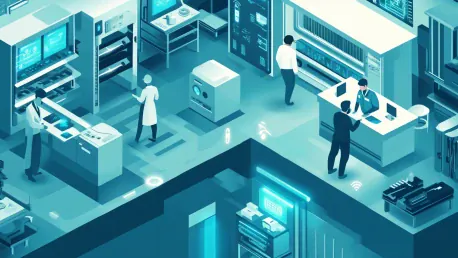As businesses strive to enhance productivity and efficiency, a significant portion of the workforce—amounting to 40%—remains largely untapped by traditional IT solutions. These employees operate outside the conventional office environment, engaging in more physical tasks such as logistics, manufacturing, and field services. The potential to transform networking by empowering these workers presents an exciting and compelling business case for genuine network transformation.
The Untapped Workforce
Identifying the Missing 40%
Empowering workers has long been recognized as a core source of IT benefits, driving innovation, growth, and efficiency. Historically, IT solutions have primarily targeted office-based employees, who make up 60% of the workforce and account for 58% of labor costs. This focus has left a substantial 40% of the workforce—those who ply their trade in non-desk roles—relatively unsupported by IT. These workers include truck drivers, factory workers, and maintenance personnel, performing vital functions often removed from advanced digital tools.
The underrepresentation of non-office workers in IT advancements has led to a significant gap in productivity and efficiency gains that could be realized through technology. Bridging this gap demands a strategic focus on developing new applications and solutions tailored to the unique needs and conditions of these roles. As companies evaluate the path forward, recognizing and addressing the needs of the untapped 40% could unlock unprecedented opportunities for growth and innovation.
Challenges in Empowering the 40%
The fundamental challenge in empowering the missing 40% stems from the lack of information about their activities and work conditions. These workers are often engaged in dynamic, physical tasks where exact locations and real-time activities remain largely unknown to IT systems. To accurately understand and address these workers’ needs, comprehensive data collection through IoT sensors is essential. These sensors can provide a continuous stream of real-world data, capturing the nuances of various environments and tasks.
However, the deployment of IoT sensors and the subsequent processing of vast amounts of data present substantial logistical and technical challenges. Realizing the benefits of such deployments requires robust infrastructure, significant investment, and advanced processing capabilities to analyze and make sense of the collected data. Beyond technical hurdles, there is also a need for effective integration of these technologies within existing work processes, ensuring that the information gathered leads directly to actionable insights and performance improvements.
Ericsson’s Approach
IoT Deployment and Data Collection
Two notable companies, Ericsson and Nokia, have emerged as potential leaders in addressing the challenge of empowering the untapped 40% of the workforce. Ericsson, traditionally renowned for its telecom infrastructure expertise, has recently ventured into the realm of IoT. By leveraging its extensive experience in network technologies, Ericsson aims to deploy IoT sensors on a broad scale to gather data on real-world conditions. This initiative is intended to enhance the productivity of workers who operate outside traditional office settings by providing insights into their work environments and activities.
Ericsson’s strategy was showcased in a recent webinar where the company highlighted its collaboration with several partners. One partner focuses on providing middleware for IoT event processing, another offers a network protocol for event information exchange, and a third ensures secure and efficient IoT device connections over low-bandwidth networks. This comprehensive approach underscores the company’s commitment to creating a robust infrastructure for IoT deployment, aiming to capture and analyze data that can drive performance enhancements for the 40% of workers previously overlooked by IT solutions.
Gaps in Application Development
Despite the promising groundwork laid by Ericsson in terms of IoT deployment and data collection, significant gaps remain in the development of specific applications that directly target the productivity needs of the untapped 40%. As of now, Ericsson appears to be seeking developer and integrator partners to bridge this critical gap, indicating that the company has yet to solidify its commitment to promoting tailored applications for these workers. The success of this initiative relies heavily on the extent to which developers and integrators are encouraged and supported in creating practical, user-focused applications.
The company’s webinar showcased the essential features required to empower non-office workers but fell short of providing concrete examples of applications that could be immediately implemented. This omission suggests that while the infrastructure and tools may be in place, there is still a need for a collaborative effort to translate these capabilities into practical solutions that deliver tangible benefits. The road ahead for Ericsson will involve ensuring that such partnerships are robustly supported and that there is a clear roadmap for the development and integration of targeted applications.
Nokia’s Strategy
Leveraging Digital Twins
In contrast to Ericsson, Nokia approaches the challenge of empowering the missing 40% from a different angle, leveraging the concept of digital twins. Digital twins are sophisticated computer models that replicate real-world systems, synthesizing various data points into comprehensive understandings of complex processes. IoT data feeds into these models, enabling a nuanced, real-time depiction of operational conditions and activities that might otherwise remain fragmented and underutilized.
The advantage of digital twins lies in their ability to provide contextual insights, giving developers and integrators a user-friendly foundation to build upon. With a ready-made model for application architecture, developers can more easily create solutions tailored to the needs of non-office workers. This approach allows for more intuitive and coherent application development, potentially accelerating the creation of impactful tools that can enhance productivity for the 40% previously neglected by IT advancements.
User-Friendly Application Development
Nokia’s focus on digital twins offers a significant advantage by simplifying the path to application development. By providing a pre-built framework, developers and integrators can focus on crafting applications that address specific needs without having to start from scratch. This user-friendly starting point could prove instrumental in driving the adoption of new technologies among non-office workers. However, similar to Ericsson, Nokia has yet to make direct connections to the missing 40%, indicating room for further development and targeted efforts.
The potential of digital twins extends beyond simple data collection. These models can simulate various scenarios, providing predictive insights and facilitating proactive measures to enhance worker safety and productivity. For instance, digital twins could forecast potential equipment failures, allowing for preemptive maintenance and minimizing downtime. Despite these capabilities, the current gap lies in translating these advanced features into applications that are directly accessible and beneficial to non-office workers. Overcoming this hurdle requires strategic partnerships and continued innovation to ensure that the technology delivers maximum value.
The Path Forward
Existing Tools and Technologies
The delay in fully leveraging IoT and digital twin technologies to empower the 40% is puzzling, especially given the array of available tools and technologies. IoT sensors can capture detailed, real-world data, providing a continuous feed of information that, when processed and analyzed, reveals valuable insights into worker activities. Additionally, video and AI analysis can be used to visualize and understand complex tasks, streamlining workflows and enhancing efficiency. Augmented reality (AR) and virtual reality (VR) glasses can further elevate the worker experience, offering real-time guidance and support directly in the field.
Despite these promising technologies, challenges remain in integrating them seamlessly into existing work processes. Developing a cohesive system that leverages these tools effectively requires a clear vision and strategic planning. Companies must prioritize the creation of user-friendly applications that provide direct, actionable benefits to non-office workers. While the tools exist, they must be harnessed in a way that addresses the unique challenges of physical, dynamic workplaces.
Vision for the Future of Work
Creating a unified vision for the future of work is essential to overcoming the current challenges and fully empowering the 40%. Building broad interest in transformational projects is vital not only for generating internal support within enterprises but also for attracting attention from prospective buyers and investors. A cohesive, forward-thinking strategy can create the necessary buzz and excitement to drive adoption and innovation.
A unified vision involves integrating various technologies into a seamless ecosystem that supports continuous improvement and adaptation. This could mean developing platforms that combine IoT, AI, AR, and VR to provide a holistic solution for non-office workers. Companies must also foster collaboration among developers, integrators, and end-users to ensure that the solutions created are practical, effective, and user-friendly. By prioritizing a comprehensive, strategic approach, businesses can unlock the full potential of their workforce.
Market Excitement and Implementation
Generating Market Buzz
Generating market excitement is crucial for the successful implementation of transformational projects aimed at empowering the untapped 40%. Effective communication and public relations strategies play a key role in creating buzz and garnering interest within the industry and beyond. While neither Ericsson nor Nokia is particularly known for their prowess in public relations, this ability to excite the market could prove to be their greatest hurdle in driving widespread adoption of their technologies.
Creating a compelling narrative that highlights the benefits and potential impacts of IoT and digital twin technologies on non-office workers can attract prospective buyers and investors. By showcasing real-world examples, case studies, and success stories, these companies can demonstrate the tangible benefits of their solutions. Engaging with key stakeholders, including industry leaders, analysts, and the media, can further amplify the message and build momentum for these transformational initiatives.
Incremental Integrations
As businesses seek to boost productivity and efficiency, they often overlook a vital segment of their workforce. An estimated 40% of employees are not fully engaged by traditional IT solutions. These workers typically operate outside the conventional office settings, undertaking roles in logistics, manufacturing, and field services. These are not desk jobs; rather, they involve hands-on, physical tasks beyond the reach of standard IT frameworks.
The opportunity to revolutionize networking by equipping these employees with better tools is substantial. By focusing on this untapped workforce, companies can tap into a new realm of productivity gains. Empowering these workers with advanced networking capabilities can lead to more streamlined operations, faster communication, and overall improved efficiency. This shift not only supports workers in the field but also makes a compelling business case for genuine network transformation. Modernizing the approach to include every segment of the workforce can help drive business success in a more inclusive and efficient manner.









